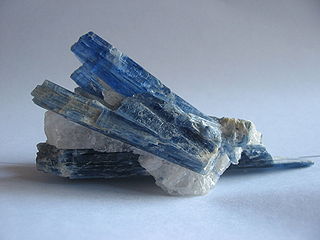
Kyanite is a typically blue aluminosilicate mineral, found in aluminium-rich metamorphic pegmatites and sedimentary rock. It is the high pressure polymorph of andalusite and sillimanite, and the presence of kyanite in metamorphic rocks generally indicates metamorphism deep in the Earth's crust. Kyanite is also known as disthene or cyanite.

In geology and mineralogy, a mineral or mineral species is, broadly speaking, a solid substance with a fairly well-defined chemical composition and a specific crystal structure that occurs naturally in pure form.
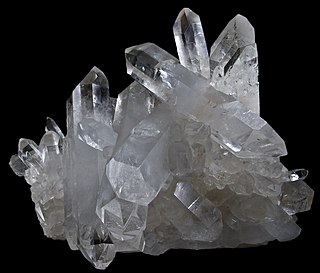
Quartz is a hard, crystalline mineral composed of silica (silicon dioxide). The atoms are linked in a continuous framework of SiO4 silicon–oxygen tetrahedra, with each oxygen being shared between two tetrahedra, giving an overall chemical formula of SiO2. Quartz is, therefore, classified structurally as a framework silicate mineral and compositionally as an oxide mineral. Quartz is the second most abundant mineral in Earth's continental crust, behind feldspar.

Hornblende is a complex inosilicate series of minerals. It is not a recognized mineral in its own right, but the name is used as a general or field term, to refer to a dark amphibole. Hornblende minerals are common in igneous and metamorphic rocks.

Chalcedony ( kal-SED-ə-nee, or KAL-sə-doh-nee) is a cryptocrystalline form of silica, composed of very fine intergrowths of quartz and moganite. These are both silica minerals, but they differ in that quartz has a trigonal crystal structure, while moganite is monoclinic. Chalcedony's standard chemical structure (based on the chemical structure of quartz) is SiO2 (silicon dioxide).

Amphibole is a group of inosilicate minerals, forming prism or needlelike crystals, composed of double chain SiO
4 tetrahedra, linked at the vertices and generally containing ions of iron and/or magnesium in their structures. Its IMA symbol is Amp. Amphiboles can be green, black, colorless, white, yellow, blue, or brown. The International Mineralogical Association currently classifies amphiboles as a mineral supergroup, within which are two groups and several subgroups.
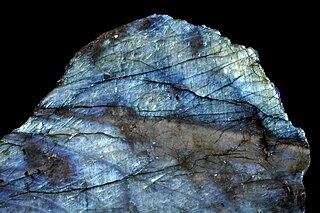
Labradorite ((Ca, Na)(Al, Si)4O8) is a calcium-enriched feldspar mineral first identified in Labrador, Canada, which can display an iridescent effect (schiller).

Tiger's eye is a chatoyant gemstone that is usually a metamorphic rock with a golden to red-brown colour and a silky lustre. As members of the quartz group, tiger's eye and the related blue-coloured mineral hawk's eye gain their silky, lustrous appearance from the parallel intergrowth of quartz crystals and altered amphibole fibres that have mostly turned into limonite.

Amphibolite is a metamorphic rock that contains amphibole, especially hornblende and actinolite, as well as plagioclase feldspar, but with little or no quartz. It is typically dark-colored and dense, with a weakly foliated or schistose (flaky) structure. The small flakes of black and white in the rock often give it a salt-and-pepper appearance.
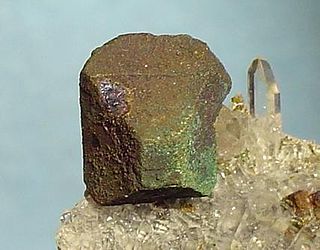
Bornite, also known as peacock ore, is a sulfide mineral with chemical composition Cu5FeS4 that crystallizes in the orthorhombic system (pseudo-cubic).
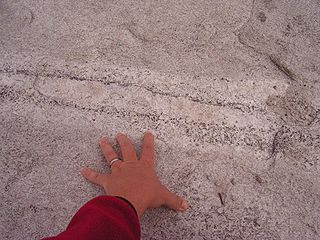
Metasomatism is the chemical alteration of a rock by hydrothermal and other fluids. It is traditionally defined as metamorphism which involves a change in the chemical composition, excluding volatile components. It is the replacement of one rock by another of different mineralogical and chemical composition. The minerals which compose the rocks are dissolved and new mineral formations are deposited in their place. Dissolution and deposition occur simultaneously and the rock remains solid.
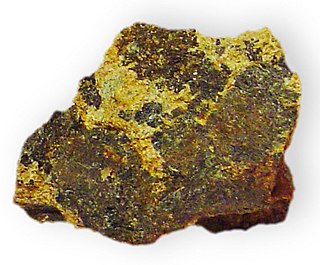
Cummingtonite is a metamorphic amphibole with the chemical composition (Mg,Fe2+
)
2(Mg,Fe2+
)
5Si
8O
22(OH)
2, magnesium iron silicate hydroxide.

Anthophyllite is an orthorhombic amphibole mineral: ☐Mg2Mg5Si8O22(OH)2 (☐ is for a vacancy, a point defect in the crystal structure), magnesium iron inosilicate hydroxide. Anthophyllite is polymorphic with cummingtonite. Some forms of anthophyllite are lamellar or fibrous and are classed as asbestos. The name is derived from the Latin word anthophyllum, meaning clove, an allusion to the most common color of the mineral. The Anthophyllite crystal is characterized by its perfect cleavage along directions 126 degrees and 54 degrees.
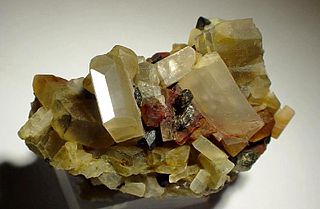
Oligoclase is a rock-forming mineral belonging to the plagioclase feldspars. In chemical composition and in its crystallographic and physical characters it is intermediate between albite (NaAlSi3O8) and anorthite (CaAl2Si2O8). The albite:anorthite molar ratio of oligoclase ranges from 90:10 to 70:30.

Komatiite is a type of ultramafic mantle-derived volcanic rock defined as having crystallised from a lava of at least 18 wt% magnesium oxide (MgO). It is classified as a 'picritic rock'. Komatiites have low silicon, potassium and aluminium, and high to extremely high magnesium content. Komatiite was named for its type locality along the Komati River in South Africa, and frequently displays spinifex texture composed of large dendritic plates of olivine and pyroxene.

Gedrite is a crystal belonging to the orthorhombic ferromagnesian subgroup of the amphibole supergroup of the double chain inosilicate minerals with the ideal chemical formula Mg2(Mg3Al2)(Si6Al2)O22(OH)2.
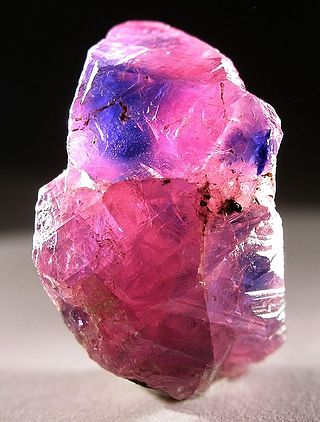
Gemstones have been found in Greenland, including diamond, ruby, sapphire, kornerupine, tugtupite, lapis lazuli, amazonite, peridot, quartz, spinel, topaz, and tourmaline. Most of Greenland's ruby and sapphire occurrences are located near the village of Fiskenaesset/Qeqertarsuatsiaat on the southwest coast.

Ferrogedrite is an amphibole mineral with the complex chemical formula of ☐Fe2+2(Fe2+3Al2)(Si6Al2)O22(OH)2. It is sodium and calcium poor, making it part of the magnesium-iron-manganese-lithium amphibole subgroup. Defined as less than 1.00 apfu (atoms per formula unit) of Na + Ca and consisting of greater than 1.00 apfu of (Mg, Fe2+, Mn2+, Li) separating it from the calcic-sodic amphiboles. It is related to anthophyllite amphibole and gedrite through coupled substitution of (Al, Fe3+) for (Mg, Fe2+, Mn) and Al for Si. and determined by the content of silicon in the standard cell.
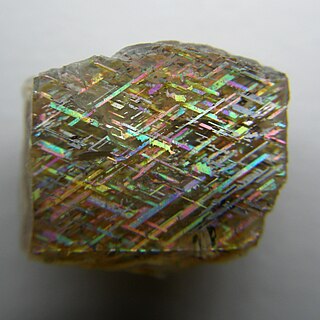
Rainbow lattice sunstone, also known as rainbow lattice, is a type of orthoclase feldspar that exhibits a rare combination of aventurescence, adularescence, and a distinctive iridescence lattice pattern. The iridescence lattice pattern consists of inclusions that are the result of crystallographically oriented exsolution crystals within the feldspar crystal. Sunstone refers to its physical appearance instead of its chemical composition.




















